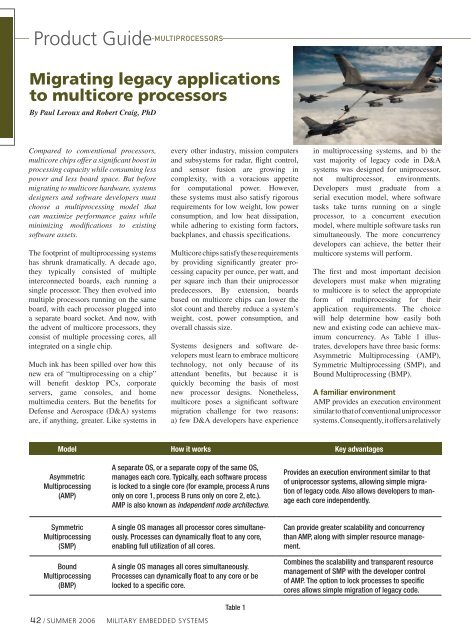Military Embedded Systems Summer 2006
Military Embedded Systems Summer 2006
Military Embedded Systems Summer 2006
Create successful ePaper yourself
Turn your PDF publications into a flip-book with our unique Google optimized e-Paper software.
Product Guide<br />
Migrating legacy applications<br />
to multicore processors<br />
By Paul Leroux and Robert Craig, PhD<br />
multiprocessors<br />
Compared to conventional processors,<br />
multicore chips offer a significant boost in<br />
processing capacity while consuming less<br />
power and less board space. But before<br />
migrating to multicore hardware, systems<br />
designers and software developers must<br />
choose a multiprocessing model that<br />
can maximize performance gains while<br />
minimizing modifications to existing<br />
software assets.<br />
The footprint of multiprocessing systems<br />
has shrunk dramatically. A decade ago,<br />
they typically consisted of multiple<br />
interconnected boards, each running a<br />
single processor. They then evolved into<br />
multiple processors running on the same<br />
board, with each processor plugged into<br />
a separate board socket. And now, with<br />
the advent of multicore processors, they<br />
consist of multiple processing cores, all<br />
integrated on a single chip.<br />
Much ink has been spilled over how this<br />
new era of “multiprocessing on a chip”<br />
will benefit desktop PCs, corporate<br />
servers, game consoles, and home<br />
multimedia centers. But the benefits for<br />
Defense and Aerospace (D&A) systems<br />
are, if anything, greater. Like systems in<br />
every other industry, mission computers<br />
and subsystems for radar, flight control,<br />
and sensor fusion are growing in<br />
complexity, with a voracious appetite<br />
for computational power. However,<br />
these systems must also satisfy rigorous<br />
requirements for low weight, low power<br />
consumption, and low heat dissipation,<br />
while adhering to existing form factors,<br />
backplanes, and chassis specifications.<br />
Multicore chips satisfy these requirements<br />
by providing significantly greater processing<br />
capacity per ounce, per watt, and<br />
per square inch than their uniprocessor<br />
predecessors. By extension, boards<br />
based on multicore chips can lower the<br />
slot count and thereby reduce a system’s<br />
weight, cost, power consumption, and<br />
overall chassis size.<br />
<strong>Systems</strong> designers and software developers<br />
must learn to embrace multicore<br />
technology, not only because of its<br />
attendant benefits, but because it is<br />
quickly becoming the basis of most<br />
new processor designs. Nonetheless,<br />
multicore poses a significant software<br />
migration challenge for two reasons:<br />
a) few D&A developers have experience<br />
in multiprocessing systems, and b) the<br />
vast majority of legacy code in D&A<br />
systems was designed for uniprocessor,<br />
not multiprocessor, environments.<br />
Developers must graduate from a<br />
serial execution model, where software<br />
tasks take turns running on a single<br />
processor, to a concurrent execution<br />
model, where multiple software tasks run<br />
simultaneously. The more concurrency<br />
developers can achieve, the better their<br />
multicore systems will perform.<br />
The first and most important decision<br />
developers must make when migrating<br />
to multicore is to select the appropriate<br />
form of multiprocessing for their<br />
application requirements. The choice<br />
will help determine how easily both<br />
new and existing code can achieve maximum<br />
concurrency. As Table 1 illustrates,<br />
developers have three basic forms:<br />
Asymmetric Multiprocessing (AMP),<br />
Symmetric Multiprocessing (SMP), and<br />
Bound Multiprocessing (BMP).<br />
A familiar environment<br />
AMP provides an execution environment<br />
similar to that of conventional uniprocessor<br />
systems. Consequently, it offers a relatively<br />
Model How it works Key advantages<br />
Asymmetric<br />
Multiprocessing<br />
(AMP)<br />
A separate OS, or a separate copy of the same OS,<br />
manages each core. Typically, each software process<br />
is locked to a single core (for example, process A runs<br />
only on core 1, process B runs only on core 2, etc.).<br />
AMP is also known as independent node architecture.<br />
Provides an execution environment similar to that<br />
of uniprocessor systems, allowing simple migration<br />
of legacy code. Also allows developers to manage<br />
each core independently.<br />
Symmetric<br />
Multiprocessing<br />
(SMP)<br />
Bound<br />
Multiprocessing<br />
(BMP)<br />
A single OS manages all processor cores simultaneously.<br />
Processes can dynamically float to any core,<br />
enabling full utilization of all cores.<br />
A single OS manages all cores simultaneously.<br />
Processes can dynamically float to any core or be<br />
locked to a specific core.<br />
Table 1<br />
Can provide greater scalability and concurrency<br />
than AMP, along with simpler resource management.<br />
Combines the scalability and transparent resource<br />
management of SMP with the developer control<br />
of AMP. The option to lock processes to specific<br />
cores allows simple migration of legacy code.<br />
42 / SUMMER <strong>2006</strong> <strong>Military</strong> EMBEDDED SYSTEMS
















